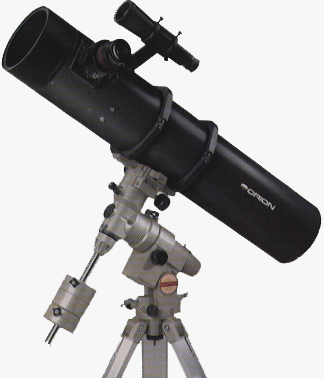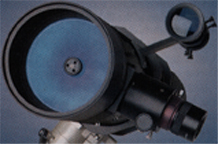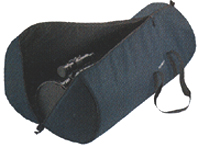Orion Introduction
Accessories
![]() News
News ![]() Products
Products ![]() Pricing
Pricing ![]() Distribution
Distribution ![]() Notes & Interesting Articles
Notes & Interesting Articles
![]()
![]()
![]() Mounts
Mounts
![]() Telescopes
Telescopes

![]()
Argonaut™ 6" (15cm) Maksutov-Newtonian Telescope
Right: Argonaut™ 6" (15cm) Maksutov-Newtonian Telescope with optional Vixen GP-DX German Equatorial Mount (69,941 Bytes)
The Orion Argonaut™ 6" (15cm) Maksutov-Newtonian is a telescope for astronomers who seek the best possible view in terms of contrast, and clarity of the planets, the moon, the sun and the brighter deep Sky objects while on a constrained budget. These Russian made telescopes are relatively lightweight, rugged and simple to maintain.
This telescope design is apochromatic (showing no false color), optimized for visual use. It provides strikingly good contrast and definition. The design provides less than one inch of back focus (distance from racked in focuser to focal plane) thereby rendering this instrument unsuitable for some photography techniques. While it may be usable for CCD imaging with a number of compatible cameras, or for Eyepiece Projection photography, this telescope is not recommended for Prime Focus photography with common 35mm SLR cameras.
History of the Mak-Newt: The component that defines the Maksutov telescope is the relatively thick deeply curved "Meniscas" corrector lens which reduces spherical aberration, a spherical Primary Mirror of about f2, and a convex Secondary Mirror (usually an aluminized spot on the Corrector Lens) which imparts magnifications of about 5X. The "Meniscas" corrector was the brainchild of two men, working independently and separated by a War. In 1941 A. Bouwers of Amsterdam, Holland and Dimitry Maksutov in Moscow, Russia were each trying to develop an alternative to the more difficult to fabricate thin Schmidt-Corrector. The Schmidt Corrector is a thin aspheric lens developed by Bernhard Schmidt in the 1920's for use in the astrographic "Schmidt Cameras" made by Carl Zeiss company in Germany. Both men arrived at about the same conclusion but since by 1944 Maksutov had published the design, history associates the lens with his name. This new lens was used to produce a compact and rugged Catadioptric (mirror and lens system) telescope. The Cassegrain aspect describes the perforated primary mirror permitting the focal plane to reach the rear of the telescope. The Meniscas Corrector and Cassegrain configuration would become known as the Maksutov-Cassegrain.
The Maksutov-Cassegrain was first popularized in the early 1950's in Lawrence Braymer's Questar 3-1/2 and later 7 inch telescopes. When properly made, these provide views very similar in detail and clarity to the finest similar aperture apochromatic refractors, yet about 1/3 or less the physical length of the typical refracting telescope. Having f ratios of f/14 or longer the Maksutov-Cassegrain lacks the versatility of the Apo refractor since the field of view and photographic possibilities are comparatively limited.
There was surprisingly little further development of the design until the early 1990's when the Maksutov Corrector Lens was employed in a configuration that would become known as the Maksutov-Newtonian. The first popular Mak-Newt was introduced by Ceravolo Optical of Ottawa, Canada. Peter Ceravolo's HD145 telescope is a carefully crafted 5.71 inch Maksutov-Newtonain, the success of this telescope became assured as the materials, consistency of production and performance were very good. The relatively high cost of this telescope compared to similar aperture commercial telescopes did not hinder its marketability - when word became known of it among the astronomy community long waiting lists soon developed. The "Mak-Newt" design provides:
- the Secondary Mirror is an elliptical flat and so the secondary mirror imparts no power as does that of the Mak-Cass or Schmidt-Cassegrain telescopes. The optics path is not "folded".
- The effective focal length of the telescope, and the overall physical length of the Mak-Newt telescope are about that of the focal length of the Primary Mirror. The Mak-Newt tube assembly is therefore notably longer than that of most Catadioptric Cassegrain designs.
- Unlike the Cassegrain design where focus is at the rear of a telescope, the Mak-Newt Primary Mirror is not perforated. The focuser of a Mak-Newt is positioned as is the traditional Newtonian - at front and to the side of the optical tube assembly.
- At f/6 the Field Curvature means the selection of good eyepiece design is critical to the observers success, even more so when observing at lower magnifications.
- Also since the back focus is very limited, then the use of some accessories (Binocular Viewers, etc.) is made more complicated if not impossible.
RECENT PRODUCTION: After the political changes transformed the Soviet Union, several new and reborn optical manufacturing facilities in Russia began production of the Mak-Newt too. Russia certainly has the people with intelligence, and aptitude - but with an economy that provides relatively less costly labor. Several companies manufactured or imported the Mak-Newtonian telescopes into the USA, marketing them under various trade names. However, the Russian made telescopes which started to appear in the USA soon after the fall of the Soviet Union were inconsistent in optical quality. These usually had relatively primitive and bulky mechanics - they were not going to win any appearance awards either. When they are right, these telescopes are awesome; unfortunately they (to some degree justly) suffered from inconsistencies of mechanical and optical quality control. Furthermore, several of the personalities affiliated with the import and distribution of Russian optics were considered by Company Seven to be "controversial".
It was not until 2001 that Company Seven chose to ally ourselves with Orion Telescopes and Binoculars in order to provide to our customers an increased measure of proven reliable supply, customer service, and another notch of influence on quality control. The Argonaut™ 6 is the first Russian made telescope that Company Seven chose to offer.
to offer these telescopes, and our customers have not been disappointed.
You may imagine you are seeing features on the moon as if you were in orbit - even though the smallest feature you could see with this telescope will actually be about 3 kilometers in diameter!
WHAT DOES IT DO? With a comparatively small central obstruction, and fewer optical surfaces, the contrast and apparent brightness can surpass more expensive designs such as the 8" Schmidt-Cassegrain telescope. This telescope has the good contrast and clarity required for stunning lunar and planetary observing; it can actually reveal changing features on several planets through out observing seasons. You may imagine you are seeing details on the moon as if you were in orbit - even though the smallest object you could see with this telescope will actually be about 3 kilometers in diameter! Star clusters may appear three dimensional, with stars floating as intense diamonds against a black velour background. Those who like to play "telescope testing" are likely to be pleasantly surprised at the Airy disk and diffraction ring patterns appearing distinct and nearly symmetrical in and out of focus, with no signs of zones or roughness - tell tale signs of patient and professional mirror making.
Aside from brilliant performance at higher magnifications, the telescope is quite at home sweeping the Milky Way, or Comet hunting. This is an easily manageable telescope with the light gathering power and fields of view to recognize many of the popular deep sky objects (Galaxies, Star Clusters, Nebulae, Planetary Nebulae, etc.). Try a TeleVue 35mm Panoptic on for size at 25x providing a true field of 2.52 degrees. Or take the plunge into awesome perfection to the TeleVue 31mm Nagler Type 5 at 28x showing 2.71 degrees - more area than the 35mm Panoptic! The combination of field of view and light gathering power will make hunting the large deep sky objects very rewarding, even more so with optional light pollution rejection filters.
 Left: front View Orion Mak-Newtonian telescope; note relatively small secondary obstruction, 2" Focuser and 50mm Finder (28,734 bytes).
Left: front View Orion Mak-Newtonian telescope; note relatively small secondary obstruction, 2" Focuser and 50mm Finder (28,734 bytes).
Noteworthy features of the Argonaut™ 6" Maksutov-Newtonian Telescope:
- Silky smooth cast and machined aluminum 2 inch diameter Crayford style focuser:
-
- 35 millimeters of focus travel,
- tension adjustments,
- drawtube position lock,
- compression ring for clamping eyepiece in place without marring it's barrel. - Fine Annealed Pyrex Primary Mirror for better thermal stability
- Fine Annealed Pyrex Secondary Mirror
- Adjustable Primary Mirror Cell
- Adjustable Secondary Mirror Cell
- Durable enhanced aluminized mirror coatings
- Optics very smoothly hand finished
- Reducer/Eyepiece Holder from 2 inch to 1.25 inch
- Hinged Tube Mounting Rings allow easy balancing, or rotation of tube to place focuser at a convenient orientation.
- Mounting Plate (attach to mount, accepts furnished Rings)
- 10x 50 Finder with Cross hair Eyepiece, 3 degree field (illuminator optional)
- Quick Release Bracket for Finder
- Dew Shield - bolted on but easily removed, 5 inch (127mm) long.
- Orion illustrated instruction manual (available in ".pdf" format from Company Seven Library)
Ordering the telescope with the Vixen GP-DX Mount adds:
- Vixen GP-DX Mount
- Fine Geared Manual Slow Motion Controls
- Setting Circles
- Aluminum Field Tripod
- Illuminated Pole Alignment Finder
 Receive a FREE TheSky SE™ Astronomy CD-ROM with purchase of any Orion-brand astronomical telescope.
Receive a FREE TheSky SE™ Astronomy CD-ROM with purchase of any Orion-brand astronomical telescope.
It is your personal planetarium and guide to the night sky. An $89 value!
Left: Orion's CD-ROM "TheSky SE" Student Edition (128,259 bytes). Click on image at left to view enlargement
To read more about the Argonaut™ 6" Maksutov-Newtonian download the Orion illustrated instruction manual from Company Seven's Library.
Note the download size is 204,420 bytes (in Acrobat Reader ".pdf" format).
TELESCOPE SPECIFICATIONS
| Specification | |
|---|---|
| Clear aperture: | 151.96mm (5.98") |
| Effective Focal length: | 900mm (35.4") |
| Secondary Obstruction: | 28.97mm (1.14") |
| Corrector: | Borosilicate Crown (BK-7) |
| Primary Mirror: | Pyrex, fine annealed |
| Secondary Mirror: | Pyrex, fine annealed |
| Corrector Lens AR Coatings: | Multi-layer on Corrector |
| P&S Mirror Reflective Coatings: | Enhanced Aluminum |
| Central Obstruction: | |
| Central Obstruction: | 19.1% by Diameter |
| Resolution (visual): | 0.77 arc seconds |
| Resolution (photo): | 0.73 arc seconds |
| Magnification range: | 18x to about 360x |
| Tube assembly: | Painted Black finish, 3mm aluminum tube |
| Focuser type: | 2 inch Helical "Crayford" design |
| Focuser Travel: | 35.3mm (1.3") |
| Back Focus: | 20.2mm (0.795") |
| Near Focus: | About 100 Yards (92m) |
| Telescope length: | 977.9cm (38.5") with 5" Dewcap |
| Tube Diameter: | 17.8cm (7.0") |
| Telescope Dia. Maximum: | 34.5cm (13.6") |
| Weight of OTA with finder: | 21 lbs. (9.5 kg) |
SUGGESTED ACCESSORIES
These are optional accessories that are not included with the telescopes that we highly recommend for your viewing pleasure and long term success:
- Equatorial Mount: A telescope of this length and torque requires a good quality, rigid platform to support it. For visual uses at calm sites the Vixen Great Polaris-DX mount is the least costly mount that we offer which can manage this telescope. for use at wind prone locations, or for applications involving imaging or other work requiring precise tracking we recommend you consider:
- Astro-Physics Model 400 GTO computer controlled "Go To" mount.
- Astro-Physics Model 600E GTO computer controlled "Go To" mount.
- Losmandy Hollywood General Machining Model GM-8 mount.
- Losmandy Hollywood General Machining Model G-11 mount.
- Guide book: "Backyard Astronomers Guide" or "Nightwatch" by Terrence Dickinson, or "Starware" by Phil Harrington. For the novice from age 8 to 15 or so up to adult. Good introductions to astronomy, the use of telescopes, and their accessories. Easy introductions to finding ones way around the night sky.
- Red LED Flashlight such as the Rigel Skylite to help one set up and use a telescope, and to read charts or a planishpere without adversely impacting the observers night vision.
- Telrad illuminated sight: to aid one in finding and centering objects in the main telescope, and learn the sky by "star hopping" from one object to another
- Planisphere: the easiest way to find what is up in the sky at any given time and date, and an aid to planning future sessions.
- Orion Collimating Eyepiece with instructions.
- Neutral Density and Color Filters to reduce the brightness of the Moon and Planets, and highlight subtle features.
- Sky Light Pollution Rejection Filter to reduce the greenish or golden background glow from city lights and darken the sky background - aid seeing faint Nebulae.

- Orion fitted Carrying Bag for safer, and more convenient transport the telescope optical tube assembly. Keep in mind that these are very convenient and lightweight bags, but are not suitable for shipping a telescope. Company Seven does design and offer custom engineered Airline Transport Association approved transport cases for those telescopes and mounts which we sell; one who travels quite a bit would find these to be cost effective protection, and convenient as well.
- Eyepieces: The eyepiece is the lens which is put into a focuser to magnify the image provided by the telescope. Proper choice of eyepieces can make or break a telescope. Typically astronomers will wish to initially set up the telescope with at least two or three eyepieces. The goals will be to address:
- Low magnification: for views of the faint deep sky objects although a 35mm to 55mm focal length eyepiece can be used on the main telescope as your finder.
- Middle Magnification eyepiece - usually between 80 to 120X, for views of
the full Moon, Star Clusters, etc.
- High magnification: 200X or more for views of the planets
Eyepiece designs such as the Plossl, Orthoscopic, traditional Erfle and some other wide angle eyepieces may show sharp clear images only in the center of the field when employed with telescopes such as this; these are acceptable as long as you realize this limitation, and find this unobtrusive. If you object to less than perfect images at the edge of the field, then Company Seven recommends eyepieces of advanced designs such as those pioneered by Al Nagler, founder of the TeleVue company. TeleVue's advanced designs include the "Nagler", "Radian", or "Panoptic" series eyepieces. These oculars will provide the widest clear, and flat field images bringing out the most in your telescope (and many other) telescopes.
Please refer to the brochure and the test report/data from Company Seven enclosed with our telescopes for detailed characterizations of suggested eyepieces:
Eyepiece Magnification Actual field of view Exit pupil 35mm Panoptic 25x 2.52 degrees 4.06mm 31mm Nagler Type 5 28x 2.71 degrees 3.59mm 27mm Panoptic 33x 1.99 degrees 3.13mm 22mm Nagler Type 4 40x 2.03 degrees 2.55mm 22mm Panoptic 40x 1.62 degrees 2.55mm 20mm Plossl 44x 1.11 degrees 2.32mm 17mm Nagler Type 4 52x 1.58 degrees 1.97mm 12mm Nagler Type 4 73x 1.11 degrees 1.39mm 9mm Nagler 98x 0.80 degrees 1.04mm 8mm Radian 110X 0.54 degrees 0.93mm 5mm Radian 176x 0.35 degrees 0.58mm - Low magnification: for views of the faint deep sky objects although a 35mm to 55mm focal length eyepiece can be used on the main telescope as your finder.
- Barlow or TeleVue "Powermate" Lens: Company Seven suggests you consider any of a number of 1.25 inch or 2 inch diameter Barlow lenses that we offer to double or more than triple your magnification. Furthermore, these accessories can project an image farther from the focuser to attain focus with most 35mm SLR cameras, optional accessories such as binocular viewers, etc. Contact Company Seven for suggestions on how to to best meet your goals.
- Telescopes such as this often put the eyepiece at position that is eay for most people to reach while sitting or standing. However, most observers will find it uncomfortable to stand bent over to observe for extended periods. For a much more enjoyable and comfortable observing experience, Company Seven recommends the Observing Chair; this is our most comfortable, flat folding, adjustable height seat. It is not inexpensive, but is so practical and can be used for camping or other times when a comfortable portable seat is desired.